Nutritional Approaches of the Changing Consumer after the Pandemic: Sustainable Potential of Phytoene and Phytofluene for Photoprotection and Skin Health
Abstract
1. Introduction
2. Materials and Methods
2.1. Search Strategy
2.2. Eligibility Criteria
2.3. Screening and Data Extraction
2.4. Risk of Bias Assessment
2.5. Study Selection and Data Extraction
3. Results
3.1. Distinct Chemical Structure and Potential of Colourless Carotenoids PT and PTF
3.2. Colourless Carotenoids Involved in Biological Actions: Potential for High Bioavailability
3.3. Sustainable Potential of PT and PTF to Maximize UV Absorption: Photoprotection of the Skin
3.4. Inner Beauty Strategy: Nutritionally Important Colourless Carotenoids as Consumer Products
3.5. A Major Source of the Common Dietary Carotenoids, PT and PTF
3.6. Safety and Stability of Dietary Carotenoids, PT and PTF
3.7. Limitations of the Present Review and Future Studies
4. Conclusions
Funding
Institutional Review Board Statement
Informed Consent Statement
Data Availability Statement
Conflicts of Interest
References
- Faria-Silva, C.; Ascenso, A.; Costa, A.M.; Marto, J.; Carvalheiro, M.; Ribeiro, H.M.; Simões, S. Feeding the skin: A new trend in food and cosmetics convergence. Trends Food Sci. Technol. 2020, 95, 21–32. [Google Scholar] [CrossRef]
- Aksoy, N.C.; Kabadayi, E.T.; Alan, A.K. An unintended consequence of COVID-19: Healthy nutrition. Appetite 2021, 166, 105430. [Google Scholar] [CrossRef]
- Messaraa, C.; Robertson, N.; Walsh, M.; Hurley, S.; Doyle, L.; Mansfield, A.; Daly, L.; Tansey, C.; Mavon, A. Clinical evidences of benefits from an advanced skin care routine in comparison with a simple routine. J. Cosmet. Dermatol. 2019, 19, 1993–1999. [Google Scholar] [CrossRef] [PubMed]
- Pang, R.; Wei, Z.; Liu, W.; Chen, Z.; Cheng, X.; Zhang, H.; Li, G.; Liu, L. Influence of the pandemic dissemination of COVID-19 on facial rejuvenation: A survey of Twitter. J. Cosmet. Dermatol. 2020, 19, 2778–2784. [Google Scholar] [CrossRef]
- Meléndez-Martínez, A.J.; Stinco, C.M.; Mapelli-Brahm, P. Skin Carotenoids in Public Health and Nutricosmetics: The Emerging Roles and Applications of the UV Radiation-Absorbing Colourless Carotenoids Phytoene and Phytofluene. Nutrients 2019, 11, 1093. [Google Scholar] [CrossRef] [PubMed]
- Draelos, Z.D. Nutrition and enhancing youthful-appearing skin. Clin. Dermatol. 2010, 28, 400–408. [Google Scholar] [CrossRef] [PubMed]
- Lee, J.; Kwon, K.H. DTC genetic test for customized cosmetics in COVID-19 pandemic: Focused on women in their 40s and 60s in Seoul, Republic of Korea. J. Cosmet. Dermatol. 2021, 20, 3085–3093. [Google Scholar] [CrossRef] [PubMed]
- Farage, M.A.; Miller, K.W.; Elsner, P.; Maibach, H.I. Intrinsic and extrinsic factors in skin ageing: A review. Int. J. Cosmet. Sci. 2008, 30, 87–95. [Google Scholar] [CrossRef]
- Lee, Y.M.; Kang, S.M.; Chung, J.H. The role of TRPV1 channel in aged human skin. J. Dermatol. Sci. 2012, 65, 81–85. [Google Scholar] [CrossRef]
- Debacq-Chainiaux, F.; Leduc, C.; Verbeke, A.; Toussaint, O. UV, stress and aging. Dermato Endocrinol. 2012, 4, 236–240. [Google Scholar] [CrossRef]
- Krutmann, J. Ultraviolet A radiation-induced biological effects in human skin: Relevance for photoaging and photodermatosis. J. Dermatol. Sci. 2000, 23, S22–S26. [Google Scholar] [CrossRef] [PubMed]
- Young, A.R.; Claveau, J.; Rossi, A.B. Ultraviolet radiation and the skin: Photobiology and sunscreen photoprotection. J. Am. Acad. Dermatol. 2017, 76, S100–S109. [Google Scholar] [CrossRef]
- Matsumura, Y.; Ananthaswamy, H.N. Short-term and long-term cellular and molecular events following UV irradiation of skin: Implications for molecular medicine. Expert Rev. Mol. Med. 2002, 4, 1–22. [Google Scholar] [CrossRef]
- Pandel, R.; Poljšak, B.; Godic, A.; Dahmane, R. Skin photoaging and the role of antioxidants in its prevention. ISRN Dermatol. 2013, 2013, 930164. [Google Scholar] [CrossRef] [PubMed]
- Engelmann, N.J.; Clinton, S.K.; Erdman, J.W., Jr. Nutritional aspects of phytoene and phytofluene, carotenoid precursors to lycopene. Adv. Nutr. 2011, 2, 51–61. [Google Scholar] [CrossRef] [PubMed]
- Cesarini, J.P.; Michel, L.; Maurette, J.M.; Adhoute, H.; Bejot, M. Immediate effects of UV radiation on the skin: Modification by an antioxidant complex containing carotenoids. Photodermatol. Photoimmunol. Photomed. 2003, 19, 182–189. [Google Scholar] [CrossRef] [PubMed]
- Heinrich, U.; Gartner, C.; Wiebusch, M.; Eichler, O.; Sies, H.; Tronnier, H.; Stahl, W. Supplementation with beta-carotene or a similar amount of mixed carotenoids protects humans from UV-induced erythema. J. Nutr. 2003, 133, 98–101. [Google Scholar] [CrossRef]
- Boelsma, E.; van de Vijver, L.P.L.; Goldbohm, R.A.; Klöpping-Ketelaars, I.A.A.; Hendriks, H.F.J.; Roza, L. Human skin condition and its associations with nutrient concentrations in serum and diet. Am. J. Clin. Nutr. 2003, 77, 348–355. [Google Scholar] [CrossRef] [PubMed]
- Krutmann, J.; Humbert, P. Nutrition for Healthy Skin; Springer: Berlin/Heidelberg, Germany, 2011; p. 15. [Google Scholar]
- Rodriguez-Concepcion, M.; Avalos, J.; Bonet, M.L.; Boronat, A.; Gomez-Gomez, L.; Hornero-Mendez, D.; Limon, M.C.; Meléndez-Martínez, A.J.; Olmedilla-Alonso, B.; Palou, A.; et al. A global perspective on carotenoids: Metabolism, biotechnology, and benefits for nutrition and health. Prog. Lipid Res. 2018, 70, 62–93. [Google Scholar] [CrossRef]
- Meléndez-Martínez, A.J.; Böhm, V.; Borge, G.I.A.; Cano, M.P.; Fikselová, M.; Gruskiene, R.; Lavelli, V.; Loizzo, M.R.; Mandić, A.I.; Brahm, P.M.; et al. Carotenoids: Considerations for Their Use in Functional Foods, Nutraceuticals, Nutricosmetics, Supplements, Botanicals, and Novel Foods in the Context of Sustainability, Circular Economy, and Climate Change. Annu. Rev. Food Sci. Technol. 2021, 12, 433–460. [Google Scholar] [CrossRef]
- Melendez-Martinez, A.J. An Overview of Carotenoids, Apocarotenoids, and Vitamin A in Agro-Food, Nutrition, Health, and Disease. Mol. Nutr. Food Res. 2019, 63, 1801045. [Google Scholar] [CrossRef] [PubMed]
- Hata, T.R.; Scholz, T.A.; Ermakov, I.V.; McClane, R.W.; Khachik, F.; Gellermann, W.; Pershing, L.K. Non-Invasive Raman Spectroscopic Detection of Carotenoids in Human Skin. J. Investig. Dermatol. 2000, 115, 441–448. [Google Scholar] [CrossRef] [PubMed]
- Britton, G.; Khachik, F. Carotenoids in Food. In Carotenoids. Volume 5: Nutrition and Health; Britton, G., Liaaen-Jensen, S., Pfander, H., Eds.; Birkhäuser: Basel, Switzerland, 2009; pp. 45–66. ISBN 978-3-7643-7501-0. [Google Scholar]
- Mortensen, A. Supplements. In Carotenoids: Volume 5: Nutrition and Health; Britton, G., Pfander, H., Liaaen-Jensen, S., Eds.; Birkhäuser: Basel, Switzerland, 2009; pp. 67–82. ISBN 978-3-7643-7501-0. [Google Scholar]
- Meléndez-Martínez, A.J.; Pérez-Gálvez, A.; Roca, M.; Estévez Santiago, R.; Olmedilla Alonso, B.; Mercadante, A.Z.; Jesús Ornelas-Paz, J.D. Biodisponibilidad de carotenoides, factores que la determinan y métodos de estimación. In Carotenoides en Agroalimentación y Salud; Meléndez-Martínez, A.J., Ed.; Editorial Terracota: Mexico City, Mexico, 2017; pp. 574–608. ISBN 978-84-15413-35-6. [Google Scholar]
- Meléndez-Martínez, A.J.; Mapelli-Brahm, P.; Benítez-González, A.; Stinco, C.M. A comprehensive review on the colorless carotenoids phytoene and phytofluene. Arch. Biochem. Biophys. 2015, 572, 188–200. [Google Scholar] [CrossRef]
- Meléndez-Martínez, A.J.; Mapelli-Brahm, P.; Stinco, C.M. The colourless carotenoids phytoene and phytofluene: From dietary sources to their usefulness for the functional foods and nutricosmetics industries. J. Food Compos. Anal. 2018, 67, 91–103. [Google Scholar] [CrossRef]
- Aust, O.; Stahl, W.; Sies, H.; Tronnier, H.; Heinrich, U. Supplementation with tomato-based products increases lycopene, phytofluene, and phytoene levels in human serum and protects against UV-light-induced erythema. Int. J. Vitam. Nutr. Res. 2005, 75, 54–60. [Google Scholar] [CrossRef]
- Meléndez-Martínez, A.J.; Mapelli-Brahm, P. The undercover colorless carotenoids phytoene and phytofluene: Importance in agro-food and health in the Green Deal era and possibilities for innovation. Trends Food Sci. Technol. 2021, 116, 255–263. [Google Scholar] [CrossRef]
- Khachik, F.; Carvalho, L.; Bernstein, P.S.; Muir, G.J.; Zhao, D.Y.; Katz, N.B. Chemistry, distribution, and metabolism of tomato carotenoids and their impact on human health. Exp. Biol. Med. 2002, 227, 845–851. [Google Scholar] [CrossRef]
- Campbell, J.K.; Engelmann, N.J.; Lila, M.A.; Erdman, J.W., Jr. Phytoene, phytofluene, and lycopene from tomato powder differentially accumulate in tissues of male Fisher 344 rats. Nutr. Res. 2007, 27, 794–801. [Google Scholar] [CrossRef]
- Meléndez-Martínez, A.J.; Mandić, A.I.; Bantis, F.; Böhm, V.; Borge, G.I.A.; Brnčić, M.; Bysted, A.; Cano, M.P.; Dias, M.G.; Elgersma, A.; et al. A comprehensive review on carotenoids in foods and feeds: Status quo, applications, patents, and research needs. Crit. Rev. Food Sci. Nutr. 2022, 62, 1999–2049. [Google Scholar] [CrossRef] [PubMed]
- Paetau, I.; Khachik, F.; Brown, E.D.; Beecher, G.R.; Kramer, T.R.; Chittams, J.; Clevidence, B.A. Chronic ingestion of lycopene-rich tomato juice or lycopene supplements significantly increases plasma concentrations of lycopene and related tomato carotenoids in humans. Am. J. Clin. Nutr. 1998, 68, 1187–1195. [Google Scholar] [CrossRef]
- Yan, B.; Martínez-Monteagudo, S.I.; Cooperstone, J.L.; Riedl, K.M.; Schwartz, S.J.; Balasubramaniam, V.M. Impact of Thermal and Pressure-Based Technologies on Carotenoid Retention and Quality Attributes in Tomato Juice. Food. Bioprocess. Technol. 2017, 10, 808–818. [Google Scholar] [CrossRef]
- Cooperstone, J.L.; Francis, D.M.; Schwartz, S.J. Thermal processing differentially affects lycopene and other carotenoids in cis-lycopene containing, tangerine tomatoes. Food Chem. 2016, 1, 466–472. [Google Scholar] [CrossRef] [PubMed]
- Mapelli-Brahm, P.; Corte-Real, J.; Melendez-Martinez, A.J.; Bohn, T. Bioaccessibility of phytoene and phytofluene is superior to other carotenoids from selected fruit and vegetable juices. Food Chem. 2017, 229, 304–311. [Google Scholar] [CrossRef]
- Campbell, J.K.; Stroud, C.K.; Nakamura, M.T.; Lila, M.A.; Erdman, J.W. Serum testosterone is reduced following short-term phytofluene, lycopene, or tomato powder consumption in F344 rats. J. Nutr. 2006, 136, 2813–2819. [Google Scholar] [CrossRef]
- Fuller, B.; Smith, D.; Howerton, A.; Kern, D. Anti-inflammatory effects of CoQ10 and colorless carotenoids. J. Cosmet. Dermatol. 2006, 5, 30–38. [Google Scholar] [CrossRef]
- Havas, F.; Krispin, S.; Meléndez-Martínez, A.J.; von Oppen-Bezalel, L. Preliminary data on the safety of phytoene and phytofluene-rich products for human use including topical application. J. Toxicol. 2018, 2018, 5475784. [Google Scholar] [CrossRef]
- Von Oppen-Bezalel, L.; Havas, F.; Ramot, O.; Kalo, E.; Fishbein, D.; Ben-Chitrit, O. Phytoene and Phytofluene for (Photo) Protection, Anti Aging, Lightening and Evening of Skin Tone. SOFW J. 2014, 140, 8–12. [Google Scholar]
- Von Oppen-Bezalel, L.; Fishbein, D.; Havas, F.; Ben-Chitrit, O.; Khaiat, A. The photoprotective effects of a food supplement tomato powder rich in phytoene and phytofluene, the colorless carotenoids, a preliminary study. Glob. Dermatol. 2015, 2, 178–182. [Google Scholar] [CrossRef]
- Meléndez-Martínez, A.J.; Nascimento, A.F.; Wang, Y.; Liu, C.; Mao, Y.; Wang, X.-D. Effect of tomato extract supplementation against high-fat diet-induced hepatic lesions. Hepatobiliary Surg. Nutr. 2013, 2, 198–208. [Google Scholar] [CrossRef] [PubMed]
- Ben-Dor, A.; Steiner, M.; Gheber, L.; Danilenko, M.; Dubi, N.; Linnewiel, K.; Zick, A.; Sharoni, Y.; Levy, J. Carotenoids activate the antioxidant response element transcription system. Mol. Cancer Ther. 2005, 4, 177–186. [Google Scholar] [CrossRef]
- Shaish, A.; Harari, A.; Kamari, Y.; Soudant, E.; Harats, D.; Ben-Amotz, A. A carotenoid algal preparation containing phytoene and phytofluene inhibited LDL oxidation in vitro. Plant. Foods Human Nutr. 2008, 63, 83–86. [Google Scholar] [CrossRef] [PubMed]
- Porrini, M.; Riso, P.; Brusamolino, A.; Berti, C.; Guarnieri, S.; Visioli, F. Daily intake of a formulated tomato drink affects carotenoid plasma and lymphocyte concentrations and improves cellular antioxidant protection. Br. J. Nutr. 2005, 93, 93–99. [Google Scholar] [CrossRef] [PubMed]
- Jeffery, J.L.; Turner, N.D.; King, S.R. Carotenoid bioaccessibility from nine raw carotenoid-storing fruits and vegetables using an in vitro model. J. Sci. Food Agric. 2012, 92, 2603–2610. [Google Scholar] [CrossRef] [PubMed]
- Mapelli-Brahm, P.; Desmarchelier, C.; Margier, M.; Reboul, E.; Meléndez Martínez, A.J.; Borel, P. Phytoene and Phytofluene Isolated from a Tomato Extract are Readily Incorporated in Mixed Micelles and Absorbed by Caco-2 Cells, as Compared to Lycopene, and SR-BI is Involved in their Cellular Uptake. Mol. Nutr. Food Res. 2018, 62, 1800703. [Google Scholar] [CrossRef] [PubMed]
- Mapelli-Brahm, P.; Margier, M.; Desmarchelier, C.; Halimi, C.; Nowicki, M.; Borel, P.; Meléndez-Martínez, A.J.; Reboul, E. Comparison of the bioavailability and intestinal absorption sites of phytoene, phytofluene, lycopene and β-carotene. Food Chem. 2019, 300, 125232. [Google Scholar] [CrossRef] [PubMed]
- Moran, N.E.; Clinton, S.K.; Erdman, J.W. Differential bioavailability, clearance, and tissue distribution of the acyclic tomato carotenoids lycopene and phytoene in mongolian gerbils. J. Nutr. 2013, 143, 1920–1926. [Google Scholar] [CrossRef]
- Boileau, T.W.; Liao, Z.; Kim, S.; Lemeshow, S.; Erdman, J.W., Jr.; Clinton, S.K. Prostate carcinogenesis in N-methyl-N-nitrosourea (NMU)-testosterone-treated rats fed tomato powder, lycopene, or energy-restricted diets. J. Natl. Cancer Inst. 2003, 95, 1578–1586. [Google Scholar] [CrossRef]
- Gijsbers, L.; van Eekelen, H.D.L.M.; de Haan, L.H.J.; Swier, J.M.; Heijink, N.L.; Kloet, S.K.; Rietjens, I.M.C.M. Induction of peroxisome proliferator-activated receptor γ (PPARγ)-mediated gene expression by tomato (Solanum lycopersicum L.) extracts. J. Agric. Food Chem. 2013, 61, 3419–3427. [Google Scholar] [CrossRef] [PubMed]
- Khavkin, J.; Ellis, D.A. Aging skin: Histology, physiology, and pathology. Facial Plast. Surg. Clin. N. Am. 2011, 19, 229–234. [Google Scholar] [CrossRef]
- Stahl, W.; Sies, H. β-Carotene and other carotenoids in protection from sunlight. Am. J. Clin. Nutr. 2012, 96, 1179–1184. [Google Scholar] [CrossRef]
- Vollmer, D.L.; West, V.A.; Lephart, E.D. Enhancing Skin Health: By Oral Administration of Natural Compounds and Minerals with Implications to the Dermal Microbiome. Int. J. Mol. Sci. 2018, 19, 3059. [Google Scholar] [CrossRef]
- Moher, D.; Liberati, A.; Tetzlaff, J.; Altman, D.G.; Prisma, G. Preferred reporting items for systematic reviews and meta-analyses: The PRISMA statement. PLoS Med. 2009, 6, e1000097. [Google Scholar] [CrossRef] [PubMed]
- Powls, R.; Britton, G. The roles of isomers of phytoene, phytofluene and zeta-carotene in carotenoid biosynthesis by a mutant strain of Scenedesmus obliquus. Arch. Microbiol. 1977, 115, 175–179. [Google Scholar] [CrossRef] [PubMed]
- Lu, S.; Li, L. Carotenoid Metabolism: Biosynthesis, Regulation, and beyond. J. Integr. Plant. Biol. 2008, 50, 778–785. [Google Scholar] [CrossRef] [PubMed]
- Cazzonelli, C.I.; Pogson, B.J. Source to sink: Regulation of carotenoid biosynthesis in plants. Trends Plant Sci. 2010, 15, 266–274. [Google Scholar] [CrossRef] [PubMed]
- Fraser, P.D.; Bramley, P.M. The Biosynthesis and Nutritional Uses of Carotenoids. Prog. Lipid Res. 2004, 43, 228–265. [Google Scholar] [CrossRef]
- Meléndez-Martínez, A.J.; Britton, G.; Vicario, I.M.; Heredia, F.J. Relationship between the colour and the chemical structure of carotenoid pigments. Food Chem. 2007, 101, 1145–1150. [Google Scholar] [CrossRef]
- Britton, G.; Liaaen-Jensen, S.; Pfander, H. Carotenoids Hand Book; Birkhäuser: Basel, Switzerland, 2004. [Google Scholar]
- Rodrigues, D.B.; Chitchumroonchokchai, C.; Mariutti, L.R.B.; Mercadante, A.Z.; Failla, M.L. Comparison of Two Static In Vitro Digestion Methods for Screening the Bioaccessibility of Carotenoids in Fruits, Vegetables, and Animal Products. J. Agric. Food Chem. 2017, 65, 11220–11228. [Google Scholar] [CrossRef] [PubMed]
- Richelle, M.; Bortlik, K.; Liardet, S.; Hager, C.; Lambelet, P.; Baur, M.; Applegate, L.A.; Offord, E.A. A food-based formulation provides lycopene with the same bioavailability to humans as that from tomato paste. J. Nutr. 2002, 132, 404–408. [Google Scholar] [CrossRef] [PubMed]
- Edwards, A.J.; Vinyard, B.T.; Wiley, E.R.; Brown, E.D.; Collins, J.K.; Perkins-Veazie, P.; Baker, R.A.; Clevidence, B.A. Consumption of watermelon juice increases plasma concentrations of lycopene and beta-carotene in humans. J. Nutr. 2003, 133, 1043–1050. [Google Scholar] [CrossRef]
- Mapelli-Brahm, P.; Meléndez-Martínez, A.J. The colourless carotenoids phytoene and phytofluene: Sources, consumption, bioavailability and health effects. Curr. Opin. Food Sci. 2021, 41, 201–209. [Google Scholar] [CrossRef]
- Desmarchelier, C.; Borel, P. Overview of carotenoid bioavailability determinants: From dietary factors to host genetic variations. Trends Food Sci. Technol. 2017, 69, 270–280. [Google Scholar] [CrossRef]
- Mapelli-Brahm, P.; Stinco, C.M.; Meléndez-Martínez, A.J. Comparative study of the bioaccessibility of the colorless carotenoids phytoene and phytofluene in powders and pulps of tomato: Microstructural analysis and effect of addition of sunflower oil. Food Funct. 2018, 9, 5016–5023. [Google Scholar] [CrossRef] [PubMed]
- Vinarov, Z.; Abrahamsson, B.; Artursson, P.; Batchelor, H.; Berben, P.; Bernkop-Schnürch, A.; Butler, J.; Ceulemans, J.; Davies, N.; Dupont, D.; et al. Current Challenges and Future Perspectives in Oral Absorption Research: An Opinion of the UNGAP Network. Adv. Drug Deliv. Rev. 2021, 171, 289–331. [Google Scholar] [CrossRef]
- Bohn, T.; Desmarchelier, C.; Dragsted, L.O.; Nielsen, C.S.; Stahl, W.; Rühl, R.; Keijer, J.; Borel, P. Host-Related Factors Explaining Interindividual Variability of Carotenoid Bioavailability and Tissue Concentrations in Humans. Mol. Nutr. Food Res. 2017, 61, 1–37. [Google Scholar] [CrossRef] [PubMed]
- Reboul, E. Absorption of Vitamin A and Carotenoids by the Enterocyte: Focus on Transport Proteins. Nutrients 2013, 5, 3563–3581. [Google Scholar] [CrossRef]
- Basu, A.; Imrhan, V. Tomatoes versus lycopene in oxidative stress and carcinogenesis: Conclusions from clinical trials. Eur. J. Clin. Nutr. 2007, 61, 295–303. [Google Scholar] [CrossRef] [PubMed]
- Jacques, P.F.; Lyass, A.; Massaro, J.M.; Vasan, R.S.; D’Agostino Sr, R.B. Relationship of lycopene intake and consumption of tomato products to incident CVD. Br. J. Nutr. 2013, 110, 545–551. [Google Scholar] [CrossRef] [PubMed]
- Biehler, E.; Alkerwi, A.A.; Hoffmann, L.; Krause, E.; Guillaume, M.; Lair, M.L.; Bohn, T. Contribution of violaxanthin, neoxanthin, phytoene and phytofluene to total carotenoid intake: Assessment in Luxembourg. J. Food Compos. Anal. 2012, 25, 56–65. [Google Scholar] [CrossRef]
- Stinco, C.M.; Fernández-Vázquez, R.; Escudero-Gilete, M.L.; Heredia, F.J.; Meléndez-Martínez, A.J.; Vicario, I.M. Effect of orange juices processing on the color, particle size, and bioaccessibility of carotenoids. J. Agric. Food Chem. 2012, 60, 1447–1455. [Google Scholar] [CrossRef]
- Ascenso, A.; Ribeiro, H.; Marques, H.C.; Oliveira, H.; Santos, C.; Simões, S. Chemoprevention of photocarcinogenesis by lycopene. Exp. Dermatol. 2014, 23, 874–878. [Google Scholar] [CrossRef] [PubMed]
- Young, A.R. Acute effects of UVR on human eyes and skin. Prog. Biophys. Mol. Biol. 2006, 92, 80–85. [Google Scholar] [CrossRef]
- Baier, J.; Maisch, T.; Maier, M.; Landthaler, M.; Bäumler, W. Direct detection of singlet oxygen generated by UVA irradiation in human cells and skin. J. Investig. Dermatol. 2007, 127, 1498–1506. [Google Scholar] [CrossRef] [PubMed]
- Kielbassa, C.; Roza, L.; Epe, B. Wavelength dependence of oxidative DNA damage induced by UV and visible light. Carcinogenesis 1997, 18, 811–816. [Google Scholar] [CrossRef] [PubMed]
- Godar, D.E.; Urbach, F.; Gasparro, F.P.; van der Leun, J.C. UV doses of young adults. Photochem. Photobiol. 2003, 77, 453–457. [Google Scholar] [CrossRef]
- Brenneisen, P.; Sies, H.; Scharffetter-Kochanek, K. Ultraviolet-B irradiation and matrix metalloproteinases: From induction via signaling to initial events. Ann. N. Y. Acad. Sci. 2002, 973, 31–43. [Google Scholar] [CrossRef]
- Yaar, M.; Eller, M.S.; Gilchrest, B.A. Fifty years of skin aging. J. Investig. Dermatol. Symp. Proc. 2002, 7, 51–58. [Google Scholar] [CrossRef]
- Gilchrest, B.A. Skin aging and photoaging. Dermatol. Nurs. 1990, 2, 79–82. [Google Scholar]
- Huang, A.H.; Chien, A.L. Photoaging: A review of current literature. Curr. Dermatol. Rep. 2020, 9, 22–29. [Google Scholar] [CrossRef]
- Afag, F.; Mukhtar, H. Botanical antioxidants in the prevention of photocarcinogenesis and photoaging. Exp. Derm. 2006, 15, 678–684. [Google Scholar] [CrossRef]
- Brenner, M.; Hearing, V.J.V.J. The protective role of melanin against UV damage in human skin. Photochem. Photobiol. 2008, 84, 539–549. [Google Scholar] [CrossRef]
- Geng, R.; Kang, S.-G.; Huang, K.; Tong, T. Boosting the Photoaged Skin: The Potential Role of Dietary Components. Nutrients 2021, 13, 1691. [Google Scholar] [CrossRef] [PubMed]
- Lowe, N.J. Sun Protection Factor: Comparative Techniques and Selection of UV Sources. In Sunscreens, Development, Evaluation and Regulatory Aspects; Lowe, N.J., Shaath, N., Eds.; Marcel Dekker: New York, NY, USA, 1990; pp. 379–394. [Google Scholar]
- Olmedilla-Alonso, B.; Benítez-González, A.M.; Estévez-Santiago, R.; Mapelli-Brahm, P.; Stinco, C.M.; Meléndez-Martínez, A.J. Assessment of Food Sources and the Intake of the Colourless Carotenoids Phytoene and Phytofluene in Spain. Nutrients 2021, 13, 4436. [Google Scholar] [CrossRef] [PubMed]
- Mathews Roth, M.M.; Pathak, M.A.; Mathews-Roth, M.M.; Pathak, M.A. Phytoene as a protective agent against sunburn (>280 nm) radiation in guinea pigs. Photochem. Photobiol. 1975, 21, 261–263. [Google Scholar] [CrossRef] [PubMed]
- Mathews-Roth, M.M. Antitumor activity of β-carotene, canthaxanthin and phytoene. Oncology 1982, 39, 33–37. [Google Scholar] [CrossRef]
- Kopec, R.E.; Schick, J.; Tober, K.L.; Riedl, K.M.; Francis, D.M.; Young, G.S.; Schwartz, S.J.; Oberyszyn, T.M. Sex differences in skin carotenoid deposition and acute UVB-induced skin damage in SKH-1 hairless mice after consumption of tangerine tomatoes. Mol. Nutr. Food Res. 2015, 59, 2491–2501. [Google Scholar] [CrossRef] [PubMed]
- Cooperstone, J.L.; Tober, K.L.; Riedl, K.M.; Teegarden, M.D.; Cichon, M.J.; Francis, D.M.; Schwartz, S.J.; Oberyszyn, T.M. Tomatoes protect against development of UV-induced keratinocyte carcinoma via metabolomic alterations. Sci. Rep. 2017, 7, 5106. [Google Scholar] [CrossRef]
- Grether-Beck, S.; Marini, A.; Jaenicke, T.; Stahl, W.; Krutmann, J.; Grether-Beck, S.; Marini, A.; Jaenicke, T.; Stahl, W.; Krutmann, J. Molecular evidence that oral supplementation with lycopene or lutein protects human skin against ultraviolet radiation: Results from a double-blinded, placebo-controlled, crossover study. Br. J. Dermatol. 2017, 176, 1231–1240. [Google Scholar] [CrossRef]
- Tadmor, Y.; King, S.; Levi, A.; Davis, A.; Meir, A.; Wasserman, B.; Hirschberg, J.; Lewinson, E. Comparative fruit colouration in watermelon and tomato. Food Res. Int. 2005, 38, 837–841. [Google Scholar] [CrossRef]
- Muzumdar, S.; Ferenczi, K. Nutrition and youthful skin. Clin. Dermatol. 2021, 39, 796–808. [Google Scholar] [CrossRef] [PubMed]
- Lademann, J.; Meinke, M.C.; Sterry, W.; Darvin, M.E. Carotenoids in human skin. Exp. Dermatol. 2011, 20, 377–382. [Google Scholar] [CrossRef] [PubMed]
- Von Oppen-Bezalel, L.; Shaish, A. Application of the Colorless Carotenoids, Phytoene, and Phytofluene in Cosmetics, Wellness, Nutrition, and Therapeutics. In The Alga Dunaliella; Ben-Amotz, A., Polle, J.E.W., Rao, D.V.S., Eds.; CRC Press: New York, NY, USA, 2009; pp. 423–444. [Google Scholar]
- Pearce, E.L.; Poffenberger, M.C.; Chang, C.H.; Jones, R.G. Fueling immunity: Insights into metabolism and lymphocyte function. Science 2013, 342, 1–30. [Google Scholar] [CrossRef]
- Li, H.; Chen, A.; Zhao, L.; Bhagavathula, A.S.; Amirthalingam, P.; Rahmani, J.; Salehisahlabadi, A.; Abdulazeem, H.M.; Adebayo, O.; Yin, X. Effect of tomato consumption on fasting blood glucose and lipid profiles: A systematic review and meta-analysis of randomized controlled trials. Phytother. Res. 2020, 34, 1956–1965. [Google Scholar] [CrossRef]
- Hirsch, K.; Atzmon, A.; Danilenko, M.; Levy, J.; Sharoni, Y. Lycopene and other carotenoids inhibit estrogenic activity of 17-β-estradiol and genistein in cancer cells. Breast Cancer Res. Treat. 2007, 104, 221–230. [Google Scholar] [CrossRef]
- Mazidi, M.; Ferns, G.A.; Banach, M. A high consumption of tomato and lycopene is associated with a lower risk of cancer mortality: Results from a multiethnic cohort. Public Health Nutr. 2020, 23, 1569–1575. [Google Scholar] [CrossRef]
- Stahl, W.; Sies, H. Nutritional Protection against Photooxidative Stress in Human Skin and Eye. In Oxidative Stress. Eustress and Distress; Sies, H., Ed.; Academic Press: Cambridge, MA, USA; Elsevier: London, UK, 2020; pp. 389–402. [Google Scholar]
- Parrado, C.; Philips, N.; Gilaberte, Y.; Juarranz, A.; Gonzalez, S. Oral Photoprotection: Effective Agents and Potential Candidates. Front. Med. 2018, 5, 188. [Google Scholar] [CrossRef]
- Fania, L.; Sampogna, F.; Ricci, F.; Hyeraci, M.; Paradisi, A.; Palese, E.; Di Lella, G.; Pallotta, S.; Panebianco, A.; Candi, E.; et al. Systemic Photoprotection in Skin Cancer Prevention: Knowledge among Dermatologists. Biomolecules 2021, 11, 332. [Google Scholar] [CrossRef] [PubMed]
- Hesham, F.; Riadh, H.; Sihem, N.K. What Have We Learned about the Effects of the COVID-19 Pandemic on Consumer Behavior? Sustainability 2021, 13, 4304. [Google Scholar] [CrossRef]
- Berman, J.; Zorrilla-López, U.; Farré, G.; Zhu, C.; Sandmann, G.; Twyman, R.M.; Capell, T.; Christou, P. Nutritionally important carotenoids as consumer products. Phytochem. Rev. 2015, 14, 727–743. [Google Scholar] [CrossRef]
- Rodríguez-Rodríguez, E.; Estévez-Santiago, R.; Sánchez-Prieto, M.; Olmedilla-Alonso, B. Status and Dietary Intake of Phytoene and Phytofluene in Spanish Adults and the Effect of a Four-Week Dietary Intervention with Lutein-Rich Fruits or Vegetables. Nutrients 2022, 14, 2922. [Google Scholar] [CrossRef]
- Sies, H.; Stahl, W. Nutritional protection against skin damage from sunlight. Annu. Rev. Nutr. 2004, 24, 173–200. [Google Scholar] [CrossRef] [PubMed]
- Darvin, M.E.; Patzelt, A.; Knorr, F.; Blume-Peytavi, U.; Sterry, W.; Lademann, J. One-year study on the variation of carotenoid antioxidant substances in living human skin: Influence of dietary supplementation and stress factors. J. Biomed. Opt. 2008, 13, 044028-1–044028-9. [Google Scholar] [CrossRef] [PubMed]
- Müller, H.; Bub, A.; Watzl, B.; Rechkemmer, G. Plasma concentrations of carotenoids in healthy volunteers after intervention with carotenoid-rich foods. Eur. J. Nutr. 1999, 38, 35–44. [Google Scholar] [CrossRef] [PubMed]
- FDA. GRAS Notice 163. 2005. Available online: https://www.accessdata.fda.gov/scripts/fdcc/index.cfm?set=GRASNotices&id=163 (accessed on 12 August 2018).
- EFSA. Safety of Lycopene oleoresin from tomatoes. EFSA J. 2008, 675, 1–22. [Google Scholar]
- Cilla, A.; Bosch, L.; Barberá, R.; Alegría, A. Effect of processing on the bioaccessibility of bioactive compounds—A review focusing on carotenoids, minerals, ascorbic acid, tocopherols and polyphenols. J. Food Compos. Anal. 2018, 68, 3–15. [Google Scholar] [CrossRef]
- Ma, L.; Yang, C.; Jiang, X.; Wang, Q.; Zhang, J.; Zhang, L. Sulfur-Containing Compounds: Natural Potential Catalyst for the Isomerization of Phytofluene, Phytoene and Lycopene in Tomato Pulp. Foods 2021, 10, 1444. [Google Scholar] [CrossRef]
- Yang, C.; Jiang, X.; Ma, L.; Xiong, W.; Zhang, S.; Zhang, J.; Zhang, L. Carotenoid composition and antioxidant activities of Chinese orange-colored tomato cultivars and the effects of thermal processing on the bioactive components. J. Food Sci. 2021, 86, 1751–1765. [Google Scholar] [CrossRef]
- Frosch, P.J.; Kligman, A.M. The Duhring chamber: An improved technique for epicutaneous testing of irritant and allergic reactions. Contact Dermat. 1979, 5, 73–81. [Google Scholar] [CrossRef]
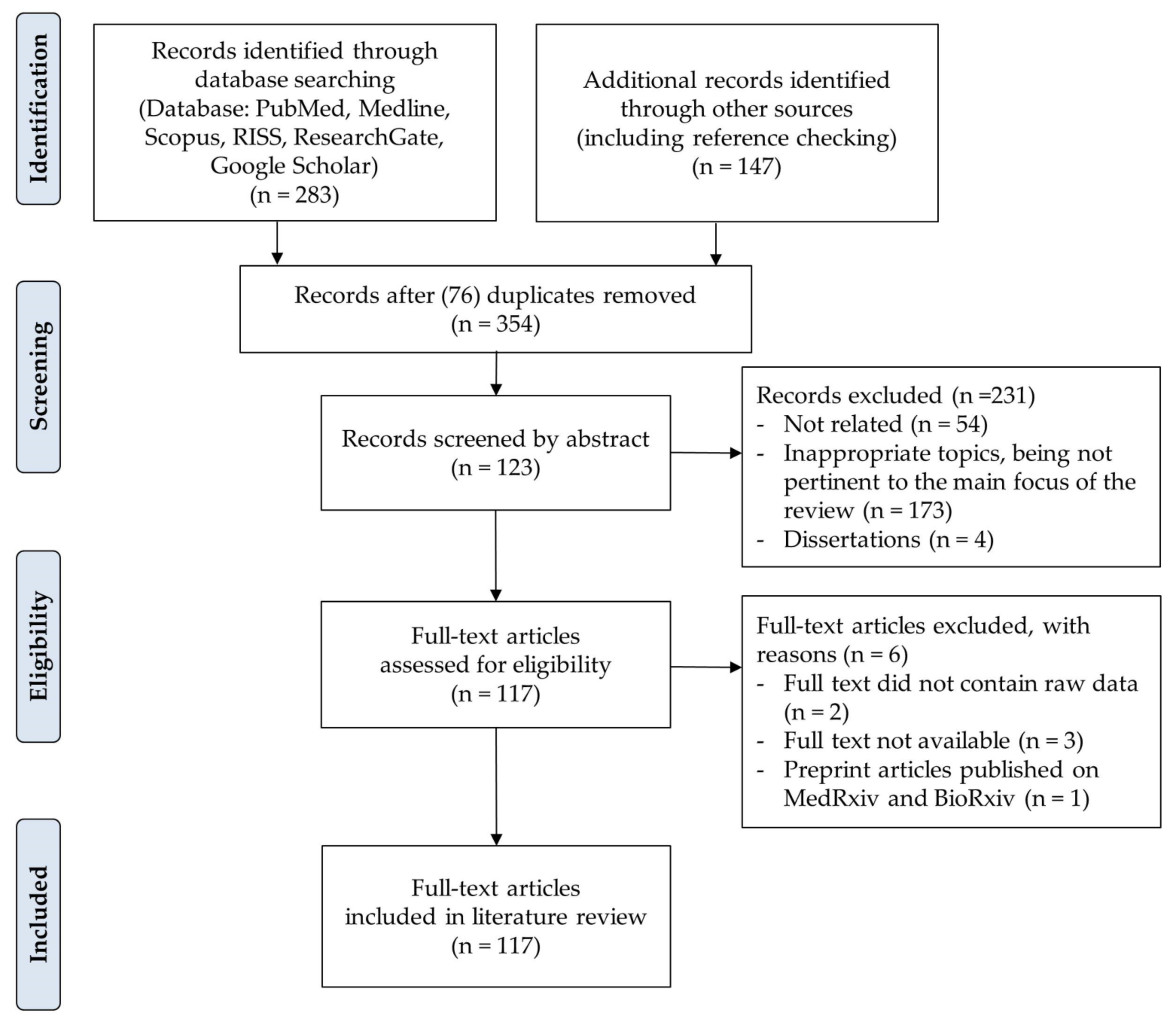
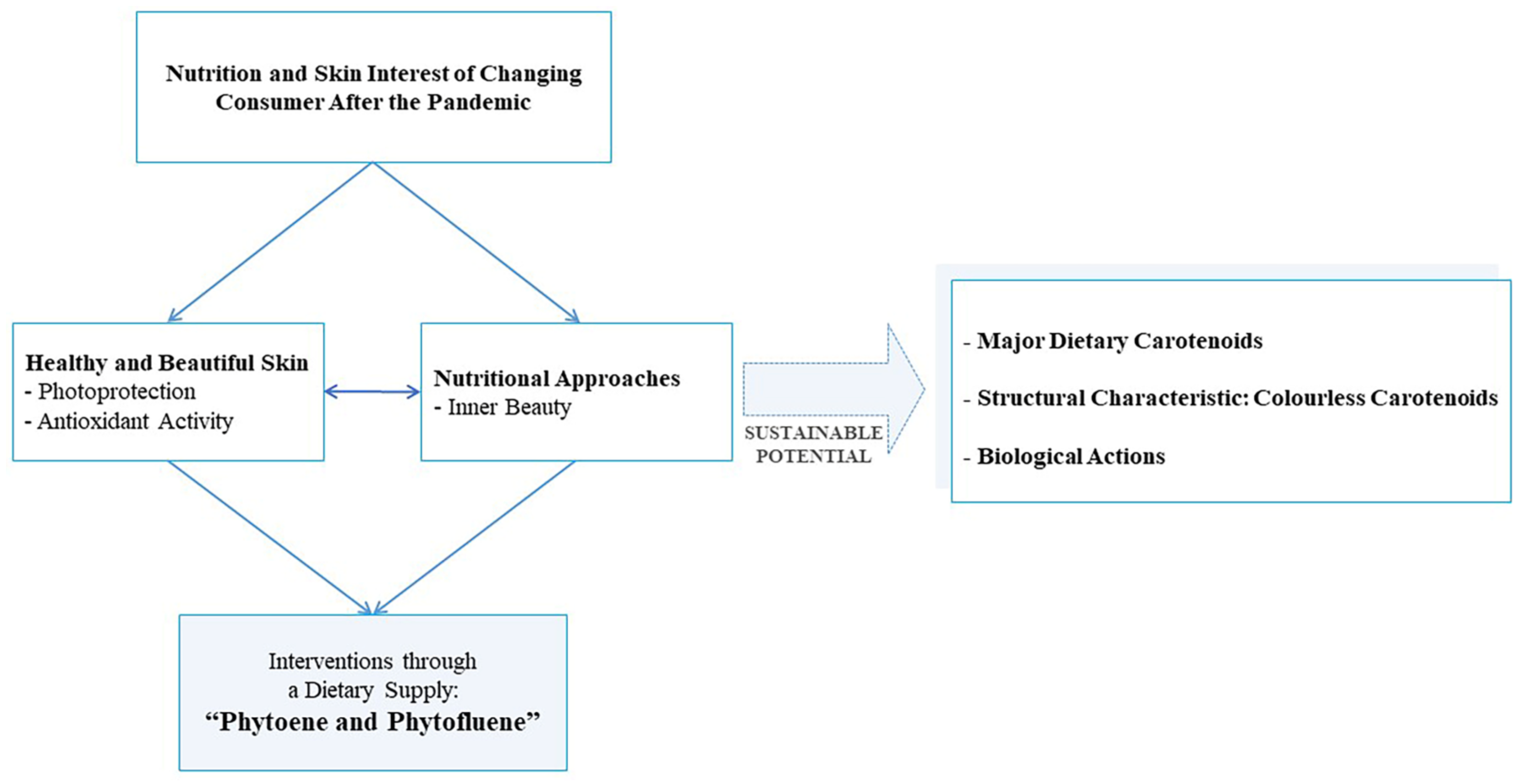

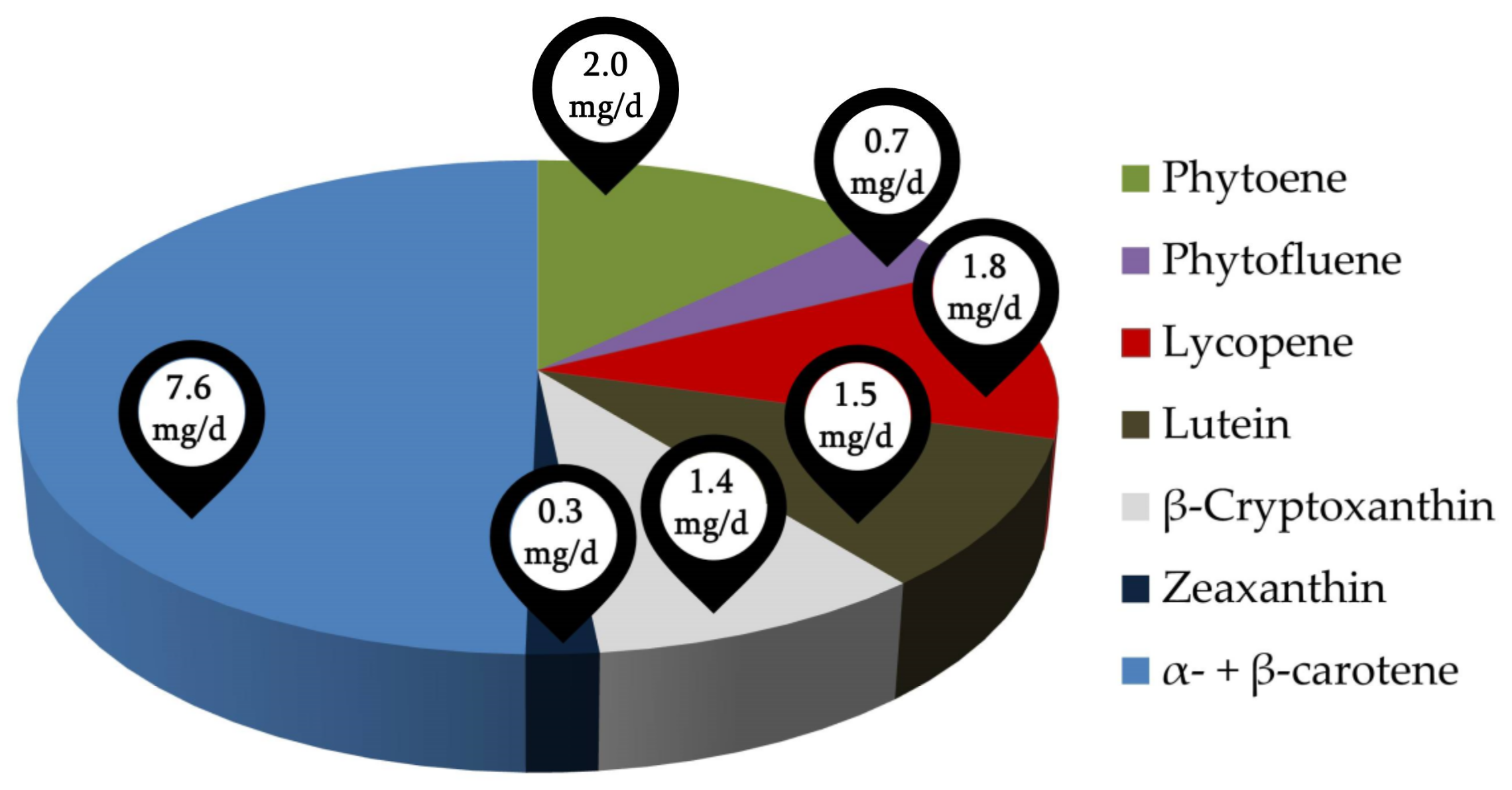
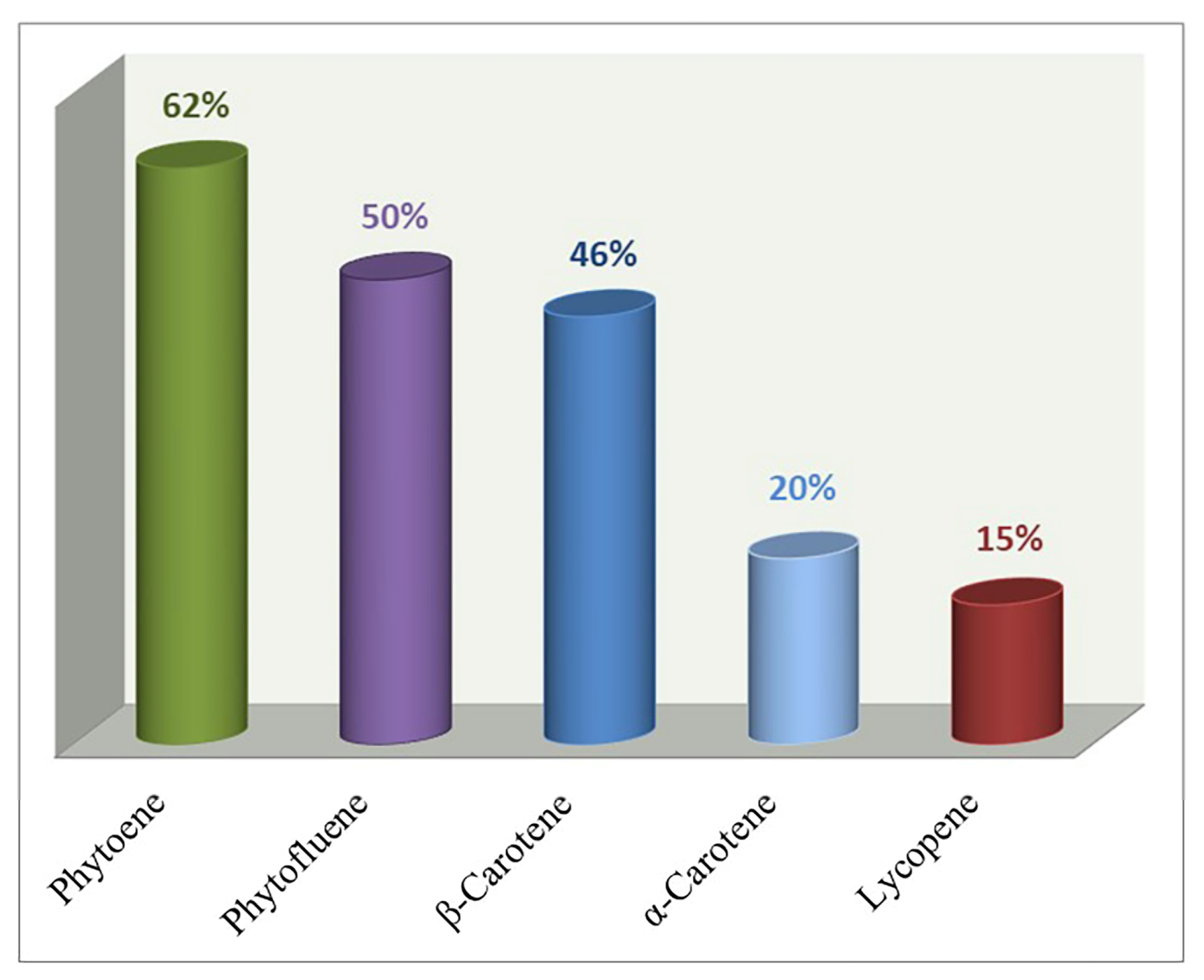
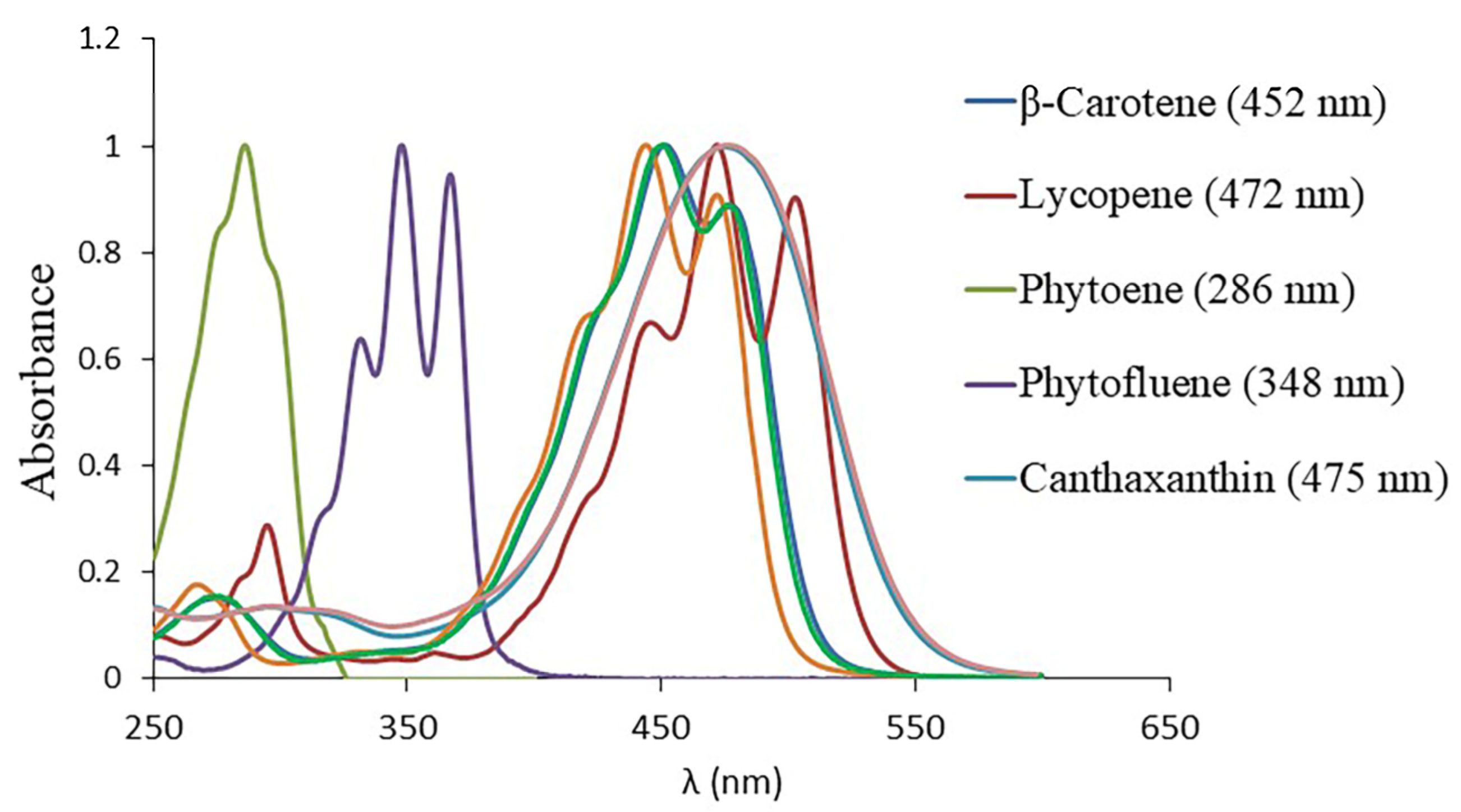
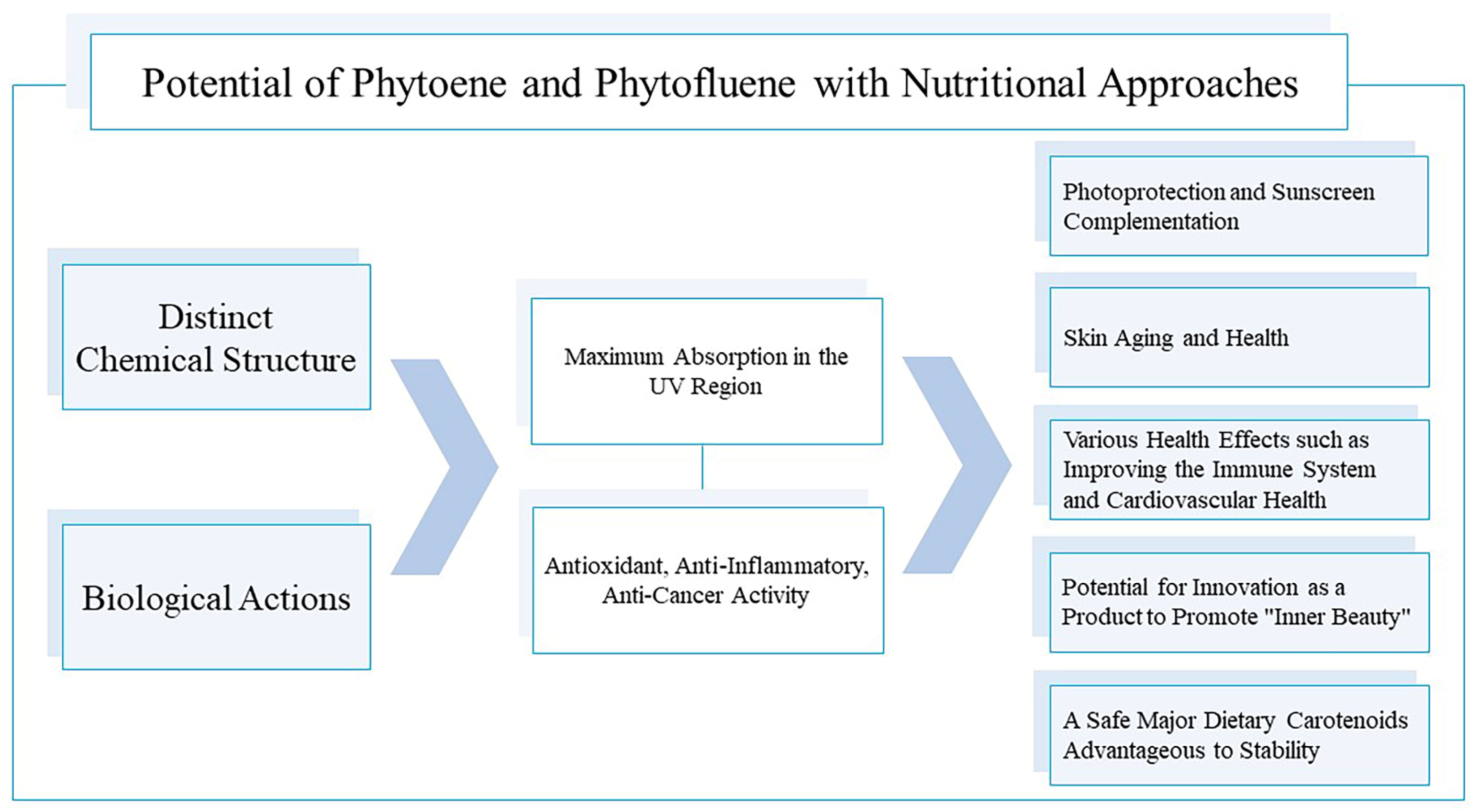

| Type of Study | Title | Key Findings | Reference |
| Review | Skin Carotenoids in Public Health and Nutricosmetics: The Emerging Roles and Applications of the UV Radiation-Absorbing Colourless Carotenoids Phytoene and Phytofluene | Unlike almost all other carotenoids, PT is rare among carotenoids because it is maximally absorbed in the UVB range and PTF is maximally absorbed in the UVA range, and maximum absorption of coloured carotenoids in the visible light range, PT and PTF have maximum absorption in the UV range. | [5] |
| Review | Nutritional Aspects of Phytoene and Phytofluene, Carotenoid Precursors to Lycopene | [15] | |
| Research Article | Supplementation with tomato-based products increases lycopene, phytofluene, and phytoene levels in human serum and protects against UV-light-induced erythema | [29] | |
| Review | A comprehensive review on the colorless carotenoids phytoene and phytofluene | [27] | |
| Research Article | The colourless carotenoids phytoene and phytofluene: From dietary sources to their usefulness for the functional foods and nutricosmetics industries | [28] | |
| Review | The undercover colorless carotenoids phytoene and phytofluene: Importance in agro-food and health in the Green Deal era and possibilities for innovation | [30] | |
| Research Article | Antitumor activity of β-carotene, canthaxanthin and phytoene | Point out the beneficial role of colourless carotenoids concerning photoprotection was the conclusion that injected doses of PT protect against UV radiation-induced erythema in guinea pigs. | [91] |
| Research Article | The photoprotective effects of a food supplement tomato powder rich in phytoene and phytofluene, the colorless carotenoids, a preliminary study | Consuming (5 mg of PT and PTF per day) tomato powder (PhytoflORAL®) increased the skin’s resistance to UV damage by increasing the MED by 20% compared to baseline for 3 months. That is, daily intake of colourless carotenoids can protect the skin from UV radiation with increased MED and the natural resistance of the skin to UV radiation-induced erythema. | [42] |
| Research Article | Supplementation with Tomato-Based Products Increases Lycopene, Phytofluene, and Phytoene Levels in Human Serum and Protects Against UV-light-induced Erythema | Volunteers given synthetic LYC, tomato extract, or tomato-based beverages (all of them supplying virtually the same LYC amount) also shows that all groups were prevented from UV radiation-induced erythema formation with greater effect in volunteers with tomato-based product than synthetic LYC. | [29] |
| Research Article | Sex differences in skin carotenoid deposition and acute UVB-induced skin damage in SKH-1 hairless mice after consumption of tangerine tomatoes | Supplementing PT- and PTF-rich tomato products mediates acute UV radiation-induced skin damage in SKH-1 mice with reduced DNA damage in both sexes, and less inflammation in the male group. | [92] |
| Research Article | Tomatoes protect against development of UV-induced keratinocyte carcinoma via metabolomic alterations | PT and PTF tomato components developed fewer UVB-induced skin tumors compared to controls, and long-term consumption of tomatoes can alleviate erythema caused by UV light. | [93] |
| Research Article | Molecular evidence that oral supplementation with lycopene or lutein protects human skin against ultraviolet radiation: results from a double-blinded, placebo-controlled, crossover study | Show that it can provide photoprotective effects by inhibiting induced UV radiation upregulation of intercellular cohesion of molecule 1, matrix metallopeptidase 1 gene, and heme oxygenase 1. | [94] |
| Type of Study | Title | Key Findings | Reference |
|---|---|---|---|
| Research Article | Molecular evidence that oral supplementation with lycopene or lutein protects human skin against ultraviolet radiation: results from a double-blinded, placebo-controlled, crossover study | Consumption of products containing colourless carotenoids can make the skin appear more beautiful, healthier, and younger. | [83] |
| Research Article | A carotenoid algal preparation containing phytoene and phytofluene inhibited LDL oxidation in vitro | Endogenous and exogenous antioxidants are an important part of reducing problems with skin cells and oxidative stress, and colourless carotenoids are highly biologically active and have antioxidant properties in vitro and in vivo. | [45] |
| Research Article | Anti-inflammatory effects of CoQ10 and colorless carotenoids | [39] | |
| Research Article | Preliminary Data on the Safety of Phytoene- and Phytofluene-Rich Products for Human Use including Topical Application | [40] | |
| Research Article | Phytoene and Phytofluene for (Photo) Protection, Anti Aging, Lightening and Evening of Skin Tone | [41] | |
| Research Article | The photoprotective effects of a food supplement tomato powder rich in phytoene and phytofluene, the colorless carotenoids, a preliminary study | [42] | |
| Research Article | Effect of tomato extract supplementation against high-fat diet-induced hepatic lesions | [33] | |
| Research Article | Serum Testosterone Is Reduced Following Short-Term Phytofluene, Lycopene, or Tomato Powder Consumption in F344 Rats | [38] | |
| Research Article | Phytoene, phytofluene, and lycopene from tomato powder differentially accumulate in tissues of male Fisher 344 rats | [32] | |
| Research Article | Carotenoids activate the antioxidant response element transcription system | [44] | |
| Research Article | Daily intake of a formulated tomato drink affects carotenoid plasma and lymphocyte concentrations and improves cellular antioxidant protection | [46] | |
| Review | Nutritional Aspects of Phytoene and Phytofluene, Carotenoid Precursors to Lycopene | [15] | |
| Review | The colourless carotenoids phytoene and phytofluene: From dietary sources to their usefulness for the functional foods and nutricosmetics industries | [28] | |
| Research Article | Daily intake of a formulated tomato drink affects carotenoid plasma and lymphocyte concentrations and improves cellular antioxidant protection | 26 healthy subjects that consumed 250 mL of tomato beverage (providing approximately 4 mg PT, 3 mg PTF, and other carotenoids) showed a reduction in DNA damage (approximately 42%) in oxidative stress lymphocytes on day 26 in a double-blind crossover study. This suggests that the intake of PT and PTF tomato beverages can affect the immune defense response due to the reduction of DNA damage in lymphocytes under oxidative stress and enhance cell antioxidant protection. | [46] |
| Research Article | The photoprotective effects of a food supplement tomato powder rich in phytoene and phytofluene, the colorless carotenoids, a preliminary study | Women were given oral administration of tomato powder rich in colourless carotenoids, and at the end of the 12-week study there was a marked improvement in overall skin beauty, including visible skin health, radiance, and so on, and daily intake of these colourless carotenoids protects the skin from UV rays. That is, PT and PTF can be an additional photoprotection aid that gives effects from within the body to the skin’s outer surface. | [42] |
| Research Article | Anti-inflammatory effects of CoQ10 and colorless carotenoids | Ingested PT and PTF have been detected in significant amounts in both human plasma and tissues including lung, liver, skin, prostate, and breast, and when accumulated in the skin can provide nutritional benefits to the skin due to their antioxidant activities. | [39] |
| Research Article | Phytoene, phytofluene, and lycopene from tomato powder differentially accumulate in tissues of male Fisher 344 rats | [32] | |
| Research Article | Daily intake of a formulated tomato drink affects carotenoid plasma and lymphocyte concentrations and improves cellular antioxidant protection | [46] | |
| Review | Nutritional Aspects of Phytoene and Phytofluene, Carotenoid Precursors to Lycopene | [15] | |
| Research Article | The colourless carotenoids phytoene and phytofluene: From dietary sources to their usefulness for the functional foods and nutricosmetics industries | In order to improve skin for health and/or beauty purposes, ingestion of PT- and PTF-rich products has additional benefits of improving the circulating and internal tissue levels of these health enhancing compounds. | [28] |
| Review | Effect of tomato consumption on fasting blood glucose and lipid profiles: A systematic review and meta-analysis of randomized controlled trials | Interventions show that the consumption of tomatoes increases high-density lipoprotein cholesterol (HDL) levels and significantly lowers cholesterol, plasma triglycerides, and low-density lipoprotein cholesterol (LDL). | [100] |
| Research Article | Lycopene and other carotenoids inhibit estrogenic activity of 17b-estradiol and genistein in cancer cells | PT and PTF have been portrayed as having advantageous impacts on health since they may lower the risk of certain types of cancer, such as breast and endometrial cancer, and cardiovascular diseases. | [101] |
| Research Article | Prostate Carcinogenesis in N-methyl-N-nitrosourea (NMU)-Testosterone-Treated Rats Fed Tomato Powder, Lycopene, or Energy-Restricted Diets | Consumption of tomato powder inhibited prostate carcinogenesis, suggesting that tomato products that contain compounds besides lycopene can modify prostate carcinogenesis. This study evidently show that tomatoes hold other compounds that can exhibition anti-cancer activity. | [51] |
| Research Article | A high consumption of tomato and lycopene is associated with a lower risk of cancer mortality: results from a multi-ethnic cohort | High dietary intake of tomatoes and LYC suggests potential beneficial effects on cancer death. | [102] |
| Research Article | Bioaccessibility of phytoene and phytofluene is superior to other carotenoids from selected fruit and vegetable juices | The dietary source of tomato juice (5 mg/250 mL juice) provided the highest amount of potentially absorbable PT and PTF. Therefore, juice can be an efficient product for intake of fruits and vegetables daily. | [37] |
| Research Article | Supplementation with Tomato-Based Products Increases Lycopene, Phytofluene, and Phytoene Levels in Human Serum and Protects Against UV-light-induced Erythema | Improved skin has been shown to have been achieved through the consumption of colourless carotenoid-containing foods or supplements. | [29] |
| Review | β-Carotene and other carotenoids in protection from sunlight | Although dietary protection in terms of SPF can be significantly lower than that achieved using sunscreen, strengthening basal protection can play an important role in long-term defense against UV radiation-induced skin aging and disorders. | [54] |
Disclaimer/Publisher’s Note: The statements, opinions and data contained in all publications are solely those of the individual author(s) and contributor(s) and not of MDPI and/or the editor(s). MDPI and/or the editor(s) disclaim responsibility for any injury to people or property resulting from any ideas, methods, instructions or products referred to in the content. |
© 2023 by the authors. Licensee MDPI, Basel, Switzerland. This article is an open access article distributed under the terms and conditions of the Creative Commons Attribution (CC BY) license (https://creativecommons.org/licenses/by/4.0/).
Share and Cite
So, B.; Kwon, K.H. Nutritional Approaches of the Changing Consumer after the Pandemic: Sustainable Potential of Phytoene and Phytofluene for Photoprotection and Skin Health. Sustainability 2023, 15, 4416. https://doi.org/10.3390/su15054416
So B, Kwon KH. Nutritional Approaches of the Changing Consumer after the Pandemic: Sustainable Potential of Phytoene and Phytofluene for Photoprotection and Skin Health. Sustainability. 2023; 15(5):4416. https://doi.org/10.3390/su15054416
Chicago/Turabian StyleSo, Bohee, and Ki Han Kwon. 2023. "Nutritional Approaches of the Changing Consumer after the Pandemic: Sustainable Potential of Phytoene and Phytofluene for Photoprotection and Skin Health" Sustainability 15, no. 5: 4416. https://doi.org/10.3390/su15054416
APA StyleSo, B., & Kwon, K. H. (2023). Nutritional Approaches of the Changing Consumer after the Pandemic: Sustainable Potential of Phytoene and Phytofluene for Photoprotection and Skin Health. Sustainability, 15(5), 4416. https://doi.org/10.3390/su15054416







